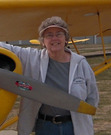Sarah Byrn Rickman's Blog, page 9
January 9, 2020
Flight to Destiny, Sarah’s 2nd WASP Novel
CHAPTER ONE (Part 1)
Annie Gwynn nudged the control stick to the left, touched her foot to the left rudder pedal, and put the small, single-engine airplane into a shallow bank. The right wing lifted and traced an invisible arc across the sky as the aircraft swung through a 180-degree turn.
The early morning mist had vanished from the green valleys between the rugged mountains that looked down on Pearl Harbor. In the two months she had been there, Annie had learned that the seasons in Hawaii didn’t change like they did in Tennessee. Back home, by early December, the trees on the gentle, rounded Green Hills south of Nashville were bare, and the sky had taken on that slate gray monochrome that comes in mid-November and stays until March. On December 7, this tropical paradise brimmed with sunshine and gloriously brilliant blossoms of red, purple, orange and yellow.
Annie bit back a yawn. She had been up since five. Both she and her roommate,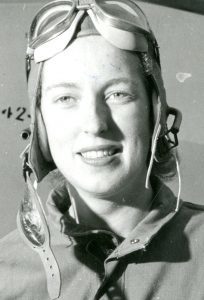 Cornelia Fort, had students scheduled to fly at sunrise — not unusual for a busy Sunday at Honolulu’s John Rodgers Civilian Airport. She could see her friend’s yellow trainer flying a half-mile away. Cornelia had taken off first and already had her student doing turns and stalls.
Cornelia Fort, had students scheduled to fly at sunrise — not unusual for a busy Sunday at Honolulu’s John Rodgers Civilian Airport. She could see her friend’s yellow trainer flying a half-mile away. Cornelia had taken off first and already had her student doing turns and stalls.
“Let’s Try Some Power-off Stalls”
When a scan of the sky told her no other airplanes were in the practice area, Annie turned to eighteen-year-old Tom Witten, who sat behind her in the enclosed cockpit. “OK, Mr. Witten,” she yelled over the noise of the engine, “let’s try some power-off stalls. Carburetor heat on, power off, stick back, nose up, back pressure, back, back. When the controls get mushy, stick forward to neutral, power on. Carb heat off. Gentle but firm.”
Cornelia Fort
She watched the nose of the plane climb the sky, her hands and feet resting lightly on her own set of controls, ready to take over in an instant if the young man sitting behind her failed to perform the maneuver correctly. To land an airplane, the pilot first has to put it into a stall. But a fledgling pilot learns how to stall by practicing high in the air where a mistake results only in a little loss of altitude, not an uncontrolled flight into the ground.
Tom did well for a beginner, she noted. You never could tell with students. The ones you expected to be bold often turned out to be the most timid once in the air, whereas the poor soul you thought was afraid of his own shadow might turn out to be a roughneck who tended to jerk the plane around all over the sky.
“My grandmother gave me the money for my birthday. I’ll be eighteen on the seventh,” the eager young man told her when he signed up for lessons. His broad chest puffed out just a bit. “I’m gonna join the Air Corps and be a pursuit pilot.”
An Instructor at Twenty-Two
Annie smiled at that. As a college graduation present last summer, Gramma Gwynn had given her the money to get her instructor’s rating. Now, barely twenty-two herself, she taught eighteen-year-olds how to fly.
And she loved flying the little J-3 Cub, single-engine trainers. 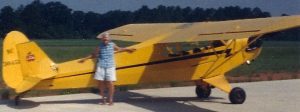
“Very nice, Mr. Witten,” she called out when Tom had three reasonably successful stalls under his belt. Then she put him to work negotiating 360-degree turns, first to the right and then to the left — to be accomplished without gaining or losing altitude. “Keep your eye on the altimeter.” She tapped her finger on the instrument panel.
Below lay the jungle — so dense, so verdant, so intense in the early morning sun, it almost hurt to look at it. Mesmerized, lulled by the drone of the engine into a momentary complacency no flight instructor could afford, Annie forced herself to look up and out beyond the crests of the hills in front of her to the brilliant gem-blue of the Pacific Ocean.
Moving Specks Caught the Sun’s Rays
Having lost track of Cornelia’s plane, she began to search for it. Instead of her friend’s yellow trainer, in the distance Annie saw moving specks— specks that caught the rays of the rising sun.
A flock of birds? Too big. Airplanes? Maybe she and Cornelia weren’t the only ones flying this morning. She squinted through the windshield. The specks — yes, airplanes — and coming toward her, closing on her.
Now she could see a formation of dozens, maybe hundreds of planes. They resembled a swarm of angry bees. Seconds later, the lead aircraft banked right and turned south and she caught sight of a red ball on the wing. The other airplanes followed the leader. All but one.
The last plane peeled off and flew toward her. With the sun behind her and shining right into the other pilot’s eyes, maybe he couldn’t see her. Nevertheless, they were on a collision course with Annie’s much smaller, slower aircraft the vulnerable one.
Alarm bells were going off in Annie’s brain. Red ball. The Rising Sun? Japanese? Impossible. But that sleek silver airplane closed on her fast.
The Silver Menace Kept Coming
“Let’s get outta here.” She yanked the controls from her student and shoved the throttle in full. Her stomach did a rollercoaster flutter as she put the airplane in a sudden dive, mindful that she didn’t have a lot of altitude to lose in these hills. But Annie knew she had to do something to evade the silver menace that came straight at her.
She heard what sounded like machine gun fire and bullets whining overhead. Keep the nose down, she thought. She swung first left and then right, hoping to spoil his aim.
“Where is he?” she yelled. “For god sake, find him. Tell me where he is.” She knew any minute a burst of those bullets would rip through the fabric of the little Cub and tear them to shreds.
“H-h-h-he’s gone, Miss Gwynn,” was Tom Witten’s stuttered response — barely audible over the engine roar.
“What?”
“Flew over us, turned, followed the others — straight south.”
Columns of Smoke Rose from Pearl Harbor
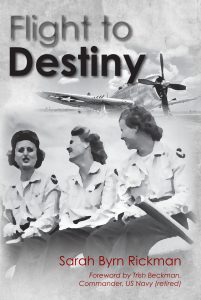
She turned in her seat and saw him pointing back toward the harbor. She eased back on the stick and banked right, beginning a gradual climb to regain her lost altitude.
Columns of smoke rose from Pearl Harbor. They fouled the bright blue morning sky with a dirty pall that threatened to obliterate the few fleecy clouds that floated high over paradise.
Continued Next Week …
Hope you like Chapter One from my second WASP novel, Flight to Destiny. Part Two coming next week.
https://www.amazon.com/s?k=Flight+to+Destiny
The post Flight to Destiny, Sarah’s 2nd WASP Novel appeared first on Sarah Byrn Rickman.
December 20, 2019
Stille Nacht / Silent Night
On December 20, 1994, the four Rickmans — we were four then — celebrated our older son’s 28th birthday in a village near Berchtesgaden, Germany. The U.S. Air Force sent him to Germany for three years and the other three of us joined him for the holidays.
For dinner that night, we journeyed up the mountain to an inn ringed by high snow-covered ridges.
We stepped from the rental car into a crisp cold that carried the hint of coming snow. Bundled in our warm parkas, we made our way across the parking lot to the entryway — a solid, weathered, heavy wooden door. Inside, light and warmth welcomed us. “ Guten Abend! ” said the smiling maître de. Returning his smile and nodding, we repeated the phrase, ours tinged with a mix of American South and Mid-West. He led us to a booth.
A CLEAN WELL-LIGHTED PLACE
A couple in their 40s, seated across the room, were heavily engrossed in conversation. They spoke rapid-fire German in a hoarse whisper. The only other occupant was a lone older gentleman clad in leather lederhosen, complete with wide suspenders, knee socks and knobbed boots. He nursed the half-litre of beer on the table in front of him.
Son number two, my fellow literati, looked around, then back at me and said, “A Clean Well-Lighted Place.” I nodded in recognition.
We settled into our familiar café-sitting and drinking mode — Americans on holiday, out to celebrate a birthday. What a contrast to the quiet despair of the middle-aged waiter and the old man in Papa Hemingway’s story by that name. For us this warm well-lighted place offered the height of togetherness and the pleasure it brings. We reveled in the evening — good sauerbraten, good local German beer, good companionship.
THREE STARS TOOK OUR BREATH AWAY
As we left the warm clean well-lighted place and approached the car, our footsteps crunched on the new fallen snow. In the frigid air, puffs of crystallized breath escaped our mouths. We talked softly, and then, almost as one, we looked up and the sight took our breath away.
Atop one of the high ridges encircling the town shone the bright white five-pointed Star of Bethlehem. A six-pointed Star of David topped the next ridge. The Star and Crescent symbol of
Islam shown from the top of a third ridge.
A circle of peace in the heart of Germany on a quiet winter night — a symbol of hope.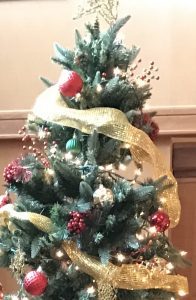
Christmas Eve, four nights later, we were back in our son’s small apartment outside Gauangelloch near Heidelberg. He and I made our way down the hill to the German Protestant Church for the 11 p.m. Christmas Eve Candlelight Service — a familiar ritual in our Methodist family. His father and brother stayed in the apartment drinking brandy.
STILLE NACHT IN PERFECT HARMONY
We understood only three words spoken or sung that night — Mary, Joseph and Bethlehem — it was enough. The two of us — church choir stalwarts — sang Stille Nacht, quietly, in English under our breath. He took the baritone harmony. I, the alto. We gloried in the rich sound of the German voices singing around us.
On the way back up the hill at midnight, church bells peeled and voices called out Christmas greetings that echoed in the frosty darkness.
That night we learned that our younger son had met a special girl. She was back in Atlanta awaiting his return from his family Christmas in Germany. Looking back, this was our last Christmas as four because she was part of our family gathering the following Christmas. Several years later, his brother added his lady to the mix.
WE ARE BLESSED!
Eventually blessed with four grandchildren, we grew to ten and remained so through Christmas of 2018. Now grampa is gone and we are nine. Still, we are blessed.
Remembering the three lighted symbols atop those ridges in Germany, may you all have a blessed holiday — according to your personal beliefs — and a healthy and prosperous New Year.
The post Stille Nacht / Silent Night appeared first on Sarah Byrn Rickman.
December 12, 2019
‘WASP Pilots’ Series Wins Combs-Gates Award
Sarah Wins Second Combs-Gates Award
… and my THANKS to the National Aviation Hall of Fame for the honor!
The National Aviation Hall of Fame (NAHF) proudly reports that Sarah Byrn Rickman’s two-volume work, “WASP Pilots,” has earned its author the 17th Annual Combs-Gates Award. The award is presented for projects that reflect an emphasis on the individual pioneers – the people – who defined America’s aerospace horizons. This is the second time Sarah has won the Combs-Gates Award. (See more below.)
The WASP Pilots Series, written for readers age 10 to adult, consists of two biographies: the World War II stories of two outstanding women pilots Nancy Love: WASP Pilot and ‘BJ’ Erickson: WASP Pilot.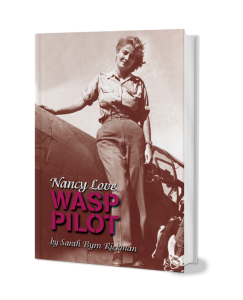
Love founded and commanded the Women’s Auxiliary Ferrying Squadron (WAFS) — 28 experienced women pilots who flew as part of the U.S. Army Air Forces beginning in fall 1942. The 28 grew in time to 303 women pilots who ferried 12,652 military aircraft, logging more than 60 million miles during WWII.
Erickson commanded a squadron of approximately 75 women ferry pilots, attached to the 6th Ferrying Group, Long Beach, CA. She proved to be an exceptional leader and was one of Love’s most versatile pilots. She ferried a wide range of Army aircraft, including the four-engine B-17 bomber and all the WWII pursuit (fighter) aircraft.
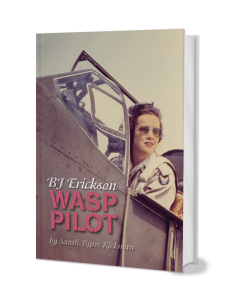 Sarah received her $20,000 cash prize on Tuesday, October 22nd, at the National Business Aviation Association’s (NBAA) 72nd annual Business Aviation Convention & Exhibition (BACE) in Las Vegas, Nevada.
Sarah received her $20,000 cash prize on Tuesday, October 22nd, at the National Business Aviation Association’s (NBAA) 72nd annual Business Aviation Convention & Exhibition (BACE) in Las Vegas, Nevada.
Sarah a Former Journalist
Sarah Byrn Rickman, who has a B.A. in English, Vanderbilt University, and an M.A. in Creative Writing, Antioch University McGregor (Ohio), is the author of nine books about the WASP. Before becoming a full-time author, Rickman worked as a reporter and columnist for The Detroit News, and later, as editor of two suburban Ohio newspapers. She has spoken on the WASP at the National Museum of the U.S. Air Force, the National WASP WWII Museum and the Ninety-Nines International Conference; and for numerous other libraries and organizations. Rickman is a pilot. She flies a vintage tailwheel aircraft.
The Combs Award [the original title] grew out of a donation to the NAHF by the late Harry Combs, a 1996 Enshrinee of the NAHF. As part of a $1.3 million gift to help fund the creation of a NAHF research center, Combs stipulated that the Combs Award be established to encourage and support relevant aviation history research and preservation efforts. A panel of expert judges review each submission based upon criteria such as historical accuracy, creativity, potential for long-term impact, and value to the NAHF’s mission of honoring America’s outstanding air and space pioneers.
Combs was instrumental to the growth and development of business aviation. Consequently, the NAHF partnered with the NBAA to host the award presentation at its annual meeting and convention, the largest business aviation event in the world. The inaugural award was presented at the Opening General Session of the NBAA’s 2003 convention, which was held in conjunction with 100th anniversary of the first powered flight. [The Wright Brothers, December 17, 1903, Kitty Hawk, NC]
The Gates-Combs Connection
John Gates and his sister, Diane G. Wallach, are co-trustees of the Gates Frontiers Fund, a foundation created by their late parents, Charles C. and June S. Gates. Mr. Gates, who passed away in 2005 at age 84, was former Chairman and CEO of the Gates Corporation, an avid multi-engine and helicopter pilot, and partner with Combs in several aviation businesses, including the Combs Gates FBO chain and Gates Learjet. This year marks the 17th year for the award and its 14th year with the name changed to reflect a multi-year commitment by the Gates Frontiers Fund to endow the award.
The award pays homage to Gates’ belief in the benefit of historic preservation to educate and inspire, and to Combs’ own research efforts behind his acclaimed 1979 book, “Kill Devil Hill: Discovering the Secrets of the Wright Brothers.” — I have read Kill Devil Hill, a terrific account of Orville and Wilbur’s dream that became a reality. I highly recommend it!
Nancy Love: WASP Pilot and BJ Erickson: WASP Pilot are written with today’s young women in mind. Our young women NEED to hear the stories of this incredible, but little known, band of women flies in WWII. They were pioneers long before most women did such avant garde things as fly. And these books are also good reads for older teens and adults. I do NOT write down to kids. I believe in challenging them to broaden their horizons. The books are simply less dense while still reflecting noteworthy WWII stories.
Book Number Three Due in 2020
WASP Pilots is an ongoing series. The third book is written and in the early stages of its path to publication. I expect to it be out in 2020, from Filter Press, the publisher of the two Combs Gates Award winners. The Love and Erickson books are on Amazon and available from the publisher. Links below.
I am currently working on finding donor partners who will work with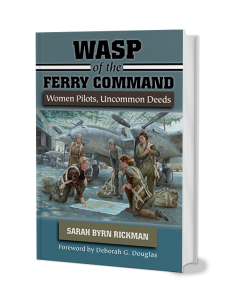 me to put these two books in the hands of girls enrolled in middle school STEM classes or aviation curriculums through the Civil Air Patrol, Charter Schools, Home School Consortiums, Scouting Programs, etc.
me to put these two books in the hands of girls enrolled in middle school STEM classes or aviation curriculums through the Civil Air Patrol, Charter Schools, Home School Consortiums, Scouting Programs, etc.
Oh yes: I also was the winner in 2009 for my body of work — five WASP books at that point — to write number six, my most ambitious and encompassing work to date: WASP of the Ferry Command: Women Pilots, Uncommon Deeds. This book is the complete story of the 303 WASP [Women Airforce Service Pilots] who flew for Nancy Love and the Ferrying Division, Air Transport Command, USAAF of WWII.
Links for my books:
Thank you for reading my BLOG!!
SBR
The post ‘WASP Pilots’ Series Wins Combs-Gates Award appeared first on Sarah Byrn Rickman.
November 19, 2019
The 99s — Women Pilots — Mark 90 Years
Saturday night, November 2, I dined with 75-plus fellow members of The Ninety-Nines, Inc., the international organization of licensed women pilots. A smattering of husbands, fondly known as 49-and-a-halfs, joined us. Our host: the 99s Museum of Women Pilots (MWP), located in Oklahoma City. Our mission: to 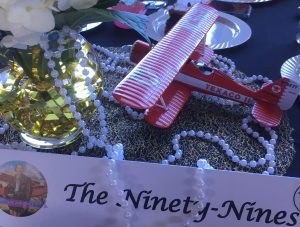 celebrate and remember the 99 women pilots who founded our organization on November 2, 1929 — 90 years ago to the day.
celebrate and remember the 99 women pilots who founded our organization on November 2, 1929 — 90 years ago to the day.
On that day in 1929, twenty-six women pilots attended the first meeting. Curtiss Airport, in Valley Stream — a village on New York’s Long Island — was the setting for the gathering. Bad weather prevented flying in, so most of the women traveled there by car or train.
Ninety-Nine Women Pilots Respond
Neva Paris was elected temporary chairman. A makeshift tea service — a toolbox on wagon wheels —
was wheeled in and the 26 paused to enjoy a hot drink, probably most welcome in the cold, drafty hangar. Discussion — whether to form a women’s flying organization — followed. The idea had merit. They drafted a letter to be sent to all 117 of America’s licensed female pilots inviting them to join. Paris, Frances Harrell, Margery Brown, and 21-year-old Fay Gillis, acting as scribe, signed the letter. Ninety-nine responded and joined. Ultimately, the women took “Ninety-Nines” as their name in recognition of their charter membership.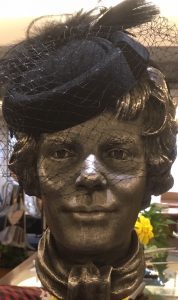
The Ninety-Nines elected the most famous woman pilot of the day, Amelia Earhart, their first president and Louise Thaden, another well known and much respected aviatrix, secretary. Thaden had won the first Women’s Transcontinental Air Race — dubbed the Powder Puff Derby — flown in mid-August that same year. The race led directly to the November 2 meeting. (A story for another blog post.)
So, 90 years later, on November 2, 2019, we modern-day Ninety-Nines toasted our beloved 99 pioneering charter members.
On the left is a photo of the museum’s bust of Amelia suitably adorned with a 1920’s style chapeau.
Knowing Fay and Nancy Was a Gift
I was fortunate enough to know two of our charter members personally. I had the privilege of working with Nancy Hopkins Tier, beginning in 1990, at the International Women’s Air and Space Museum, then located in Centerville, Ohio. [It now resides in Cleveland.] Nancy was the Chairman of IWASM’s Board of Trustees.
Through IWASM, I also met Fay Gillis Wells — a museum trustee — and the woman who, in the 1970s, founded the International Forest of Friendship in Atchison, Kansas [See my blogs from October 9th and 18th this year.]
Joan Hrubec, executive director of IWASM, and I teamed up with the head of production at our local Cable Council Community TV station, Dave Gordon, to produce, film and televise interviews with both women — as well as several others over a four year period. They brought aviation history up close and personal to our studio audience as well as people out in the South Dayton Suburban communities. The shows are still telecast for the ever-changing local audiences.
I also had the privilege of introducing Fay to my Women in Communications group in Dayton. I invited Fay — a foreign correspondent in 1930s and during World War II and later a Washington D.C. print and broadcast journalist — to be our meeting speaker. She blew my fellow local journalist friends away with her tales from the past. They LOVED her!
Then I Met Betty Huyler Gillies
Betty Huyler Gillies as a young pilot.
At the Forest of Friendship in Atchison, Kansas, in 1992, 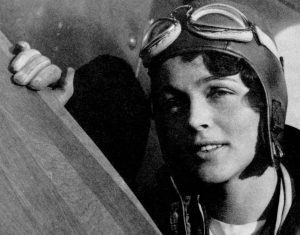 it was my privilege to meet charter Ninety-Nine Betty Huyler Gillies. I particularly wanted to meet Betty because she commanded the WASP squadron of women ferry pilots stationed at New Castle Army Air Base in World War II.
it was my privilege to meet charter Ninety-Nine Betty Huyler Gillies. I particularly wanted to meet Betty because she commanded the WASP squadron of women ferry pilots stationed at New Castle Army Air Base in World War II.
My desire to “be there” this November 2, drove me to Oklahoma City to attend the 90th anniversary dinner with my fellow 99s. It was a momental moment in history for women pilots. And I first learned about this remarkable story when I read about Amelia Earhart. That encounter between the pages of a book, when I was 13, led to my lifelong interest in aviation and the part women played in it.
My association with the WASP, the women that flew in World War II, also began at IWASM in 1990. That encounter completely changed my life. And — in turn — 29 years later, led to my presence at the 99s Museum of Women Pilots in Oklahoma City, November 2, 2019.
I joined the Ninety-Nines in July 2011. I earned my pilot’s license July 1 that year and officially signed up at Oshkosh four weeks later at the 99’s booth.
Ninety-Nines Archives and Preservation
As I’ve researched and written about the WASP over the past 20-plus years, I have visited several museums and archives in pursuit of material for my various books. I’ve developed an understanding of the archival process and have come to appreciate what all goes into it. I’ve worked directly with the WASP Archive at Texas Woman’s University since 2000 doing WASP oral histories, and writing and editing the WASP News.
A year ago, the Ninety-Nines put out the annual call for 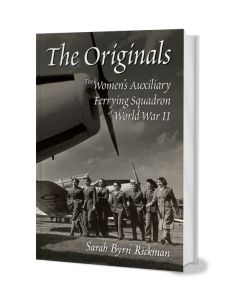 members interested in serving on the board of trustees for the Museum of Women Pilots — MWP, for short. I wondered if I would be a good fit for that job? Given my work over the past 20 years with other facilities that preserve the history of women pilots, I decided to put my hat in the ring.
members interested in serving on the board of trustees for the Museum of Women Pilots — MWP, for short. I wondered if I would be a good fit for that job? Given my work over the past 20 years with other facilities that preserve the history of women pilots, I decided to put my hat in the ring.
Thanks for reading my blog!
Read Sarah’s books about the WASP Pilots of WWII. See them all on Amazon: https://www.amazon.com/s?k=Sarah+Byrn+Rickman&i=stripbooks&ref=nb_sb_noss_2
The post The 99s — Women Pilots — Mark 90 Years appeared first on Sarah Byrn Rickman.
October 18, 2019
The Historic Chocolate Soda Lives Again
When was the last time you had a chocolate soda at a real old-fashioned soda  fountain? Think “old-fashioned” as when those of us of a certain age were kids or teenagers. Those soda fountains, as we knew them in “our” day, are rare today.
fountain? Think “old-fashioned” as when those of us of a certain age were kids or teenagers. Those soda fountains, as we knew them in “our” day, are rare today.
The day before I left for summer camp the first time, my mother took me to the soda fountain in Walgreens Drugstore, on the corner of York and East Colfax in Denver and treated me to a “going-away” chocolate soda.
Last month, I visited an old-fashioned soda fountain in renown aviatrix Amelia Earhart’s hometown of Atchison, Kansas. [See last week’s blog about my trip to Atchison and The International Forest of Friendship.]
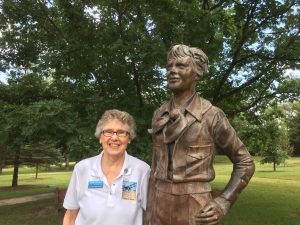
I had been to Atchison and The Forest on two prior occasions — 1992 and 2005 — but had not been to downtown Atchison. By the time I knew I was going back this year, I had heard the “chocolate soda at Ball Drug” story about Charter Ninety-Nine and Original World War II WAFS pilot and leader Betty Huyler Gillies.
Sarah with Amelia’s statue in The International Forest of Friendship
The “Chocolate Soda at Ball Drug” Story
Betty Huyler Gillies as a young pilot

The friend who told me about it suggested that I go exploring and find out if Betty’s soda fountain is still there after all these years.
Betty, one of THE outstanding woman pilots not only of the 1930s but the WWII years and afterwards as chair of the All-Woman Transcontinental Air Race, was inducted into The Forest of Friendship its inaugural year, 1976. She returned for the celebration many times after that, always supportive of her good friend and fellow Charter Ninety-Nine, Fay Gillis Wells. It was Fay who shepherded The Forest for the Ninety-Nines from the germ of an idea to the Bicentennial opening in 1976. She served as cochair until her death in 2002.
I was privileged to know Fay through the International Women’s Air and Space Museum in the 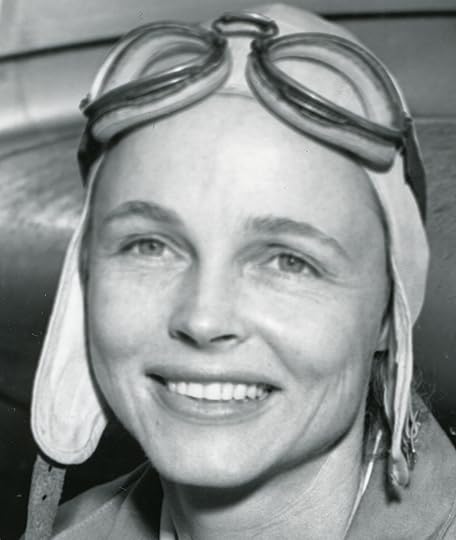 1990s and I had the pleasure of meeting Betty when I made my first visit to The Forest in 1992.
1990s and I had the pleasure of meeting Betty when I made my first visit to The Forest in 1992.
Betty Put On Her Walking Shoes
Over her many visits, Betty — who liked to walk — began to explore Atchison.
The Friday before the annual celebration, she put on her walking shoes. Exiting the Benedictine Sisters College dormitory on the hill — where the Ninety-Nines stayed in those days — she walked down into town and then up the bluff to Amelia Earhart’s birthplace and museum overlooking the Missouri River … or wherever her feet took her that day.
In 1986, walking along the Mall in downtown Atchison, she discovered Ball Drugs. It was hot that day, typical of summer in Kansas. Betty went in, sat down at the soda fountain to cool off and ordered her favorite, a chocolate soda. She found it to be quite good and returned the following day. This time she ordered a chocolate soda AND another of her favorites, a BLT.
Next year Betty returned, this time taking a couple of her Ninety-Nines friends with her. But when she tried her soda, it wasn’t quite as good as she remembered it. This puzzled her.
The next day, she went back. When everyone else said it was too hot to walk to town, Betty went alone. She asked the soda jerk what he used to make his chocolate sodas. He listed the ingredients, concluding with Vanilla ice cream.
‘Back East We Use Chocolate Ice Cream’
“That’s it,” Betty told the young man and explained that “Back East we make chocolate sodas with Chocolate ice cream!”
She asked if he could make her one with chocolate, but he told her that they got so few requests for Chocolate ice cream, they didn’t carry it. She asked him to consider ordering some chocolate in time for next year’s Forest of Friendship. He made note of it.
When Betty and her Ninety-Nines friends arrived the next year for their chocolate sodas, Ball Drug was well supplied with Chocolate ice cream. Betty had taught Atchison how to make and drink a chocolate soda East Coast Style! Seeing the number of women pilots this very special lady brought in with her each visit, Ball Drug began to order several gallons when International Forest of Friendship weekend arrived.
A tradition was born. Betty Gillies left her own indelible mark on Atchison as well as The Forest of Friendship. She became a celebrity in the eastern Kansas town.
Four Women Pilots Visit THE Soda Fountain
Just having learned about “Betty’s Chocolate Soda Legacy,” I decided to “see for myself.” My fellow 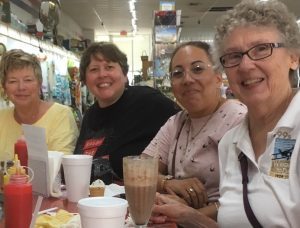 2019 IFOF inductees and I discovered that Ball Drug is gone, but the soda fountain is there — on the mall in downtown Atchison. It is still a popular place to have lunch … or a Chocolate soda or Sundae.
2019 IFOF inductees and I discovered that Ball Drug is gone, but the soda fountain is there — on the mall in downtown Atchison. It is still a popular place to have lunch … or a Chocolate soda or Sundae.
Several of us went there Friday, September 20, the day before the induction ceremony. I opted for a chocolate soda! DELICIOUS!!! – as promised! Here is a photo of four of us enjoying our lunch!
Donna Moore, Laura Smith, Ruby Bowen, Sarah Rickman
***
Amelia Earhart:
“A single act of kindness throws out root in all directions,
and the roots spring up and make new trees.”
Sarah’s Books Are On Amazon.
The post The Historic Chocolate Soda Lives Again appeared first on Sarah Byrn Rickman.
October 10, 2019
The International Forest of Friendship
Atchison, Kansas, high on a bluff overlooking the west bank of the Missouri River, is the birthplace of Amelia Earhart. Nicknamed “Lady Lindy,” she is the aviatrix who has captured the hearts and admiration of countless women and girls over several generations — including yours truly.
Because of Amelia and the organization she helped form — The Ninety-Nines, The International Organization of Women Pilots — Atchison is the home of The International Forest of Friendship. Here, trees are planted, cultivated and nurtured in celebration of flight and the individuals who choose to fly. The Forest promotes international friendship — across the skies.
The City of Atchison, the Ninety-Nines and the Kansas State University Forestry Department joined hands to create the IFOF.
Birthday Gift to the USA
The Forest was their gift to the Unites States of America on the occasion of our country’s Bicentennial, our 200th birthday — July 4, 1976.
The sign at the entrance reads:
A Bicentennial Tribute
from Members of the International Ninety-Nines
and the Citizens of Atchison, Kansas
The Forest celebrates those of us who choose to leave the earth via aircraft or spacecraft, if only momentarily, and look down on the forests, the trees, the flowers, and all the earth from the air.
“You haven’t seen a tree until you’ve seen its shadow
from the sky.”
— Amelia Earhart —
Annually, the IFOF recognizes individuals who, in their own way and through their own efforts, boost and honor aviation and/or aerospace, and encourage international understanding that can lead to international friendship. Trees planted in the Forest represent all 50 states plus more than 35 foreign countries whose citizens are so honored. Each Honoree has a brick with her/his name in the pathways of the Forest.
I was honored to be in Atchison last month (September 2019) for induction into the IFOF. A community of women associated with a very special publication, Aviatrix Aerogram, sponsored eight of us.
Laura and Amelia
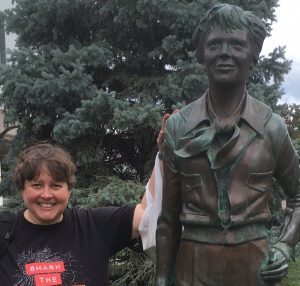 Aviatrix Aerogram is an ezine — an independent online magazine created by Laura Smith. This endeavor is Laura’s “leisure pursuit” and her passion. Laura has a day job — First Officer for a major airline. For nearly a decade, Laura has produced this aviation-focused ezine, written by women pilots about women pilots for women pilots.
Aviatrix Aerogram is an ezine — an independent online magazine created by Laura Smith. This endeavor is Laura’s “leisure pursuit” and her passion. Laura has a day job — First Officer for a major airline. For nearly a decade, Laura has produced this aviation-focused ezine, written by women pilots about women pilots for women pilots.
For the Love of It
We who write for, do editing for, and who provide support for Aviatrix Aerogram do not do this for monetary reward, but “for the love of it.” It is our opportunity to spread our wings by sharing our stories.
Amelia wrote For the Fun Of It. Again, we follow in her footsteps.
Laura is a big believer in recognizing and celebrating the accomplishments of women — this is a regular feature in the pages of Aviatrix Aerogram. Now that we are nearing the end of its publication run, Laura wanted to find a way to pay tribute to some of the women who have been a part of the publication. Now we join a long line of distinguished aviation figures in the International Forest of Friendship.
In 2018, Laura sponsored Deborah Begley into the IFOF in recognition of her work on the Production Team of Aviatrix Aerogram. Lynda Meeks and Laura jointly sponsored Heather Taylor, the producer of the award-winning documentary Breaking Through The Clouds: The First Women’s National Air Derby. Laura was joined by nine other women pilots in sponsoring Captain Becky Howell into the IFOF.
This year, nearly thirty women pilots from the Aviatrix Aerogram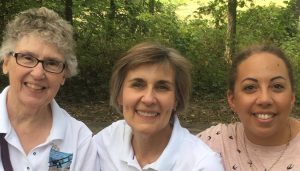 community made contributions to induct eight more into the IFOF: Sheri Baxter, Ruby Bowen, Jody “Captain Kidney” Harskamp, Donna Miller, Donna Moore, Sarah Byrn Rickman, N. Lynn Thoma, and Evelyne Tinkl.
community made contributions to induct eight more into the IFOF: Sheri Baxter, Ruby Bowen, Jody “Captain Kidney” Harskamp, Donna Miller, Donna Moore, Sarah Byrn Rickman, N. Lynn Thoma, and Evelyne Tinkl.
Sarah, Evelyne and Ruby
Our next to last issue of Aviatrix Aerogram just came out. Now we are working on the final issue. It will prominently feature this year’s Celebration at the International Forest of Friendship. To come — stay tuned.
About the Forest
The International Forest of Friendship is nestled on a gentle slope overlooking Lake Warnock, on the outskirts of Atchison. It is made up of trees from all fifty states and thirty-six territories and countries around the world where honorees reside. There are trees from George Washington’s Mount Vernon Estate, the Bicentennial American Spruce, a tree from Amelia’s grandfather’s farm, and the Moon Tree grown from a seed taken to the moon by Command Pilot Stuart Roosa on Apollo 14. This latter tree honors the 17 astronauts who gave their lives in America’s pioneering of space exploration up to 2001. In 2003 a monument near the tree was dedicated to the seven astronauts lost on the Shuttle Columbia.
Winding through the Forest are pathways honoring those who have, or still are, contributing to all facets of aviation and aerospace. The original path is called Memory Lane and leads to a secluded circle of benches in a grove of trees. All of the Forest’s walkways are five feet wide (wheel chair friendly) and embedded in them are granite plaques engraved with the names of over 1,500 honorees. More information about the honorees can be found here.
Fay Wells and Joe Carrigan: Co-Chairs
In 1976, Memory Lane was designated as the first National Recreation Trail in Kansas. In 1991, a beautiful gazebo was dedicated to Fay Wells (a founding member of the Ninety-Nines) in honor of her leadership to the Forest. A pond and waterfall honor Joe Carrigan for his many contributions as founding co-chairman. Nearby are the Amelia Earhart Earthworks and the Lake Warnock picnic grounds.
Within the overall theme of “world friendship through flight,” annual themes allow for the exploration of specific focus areas such as “discovery though flight,” “flying and forests,” “flying, forests and the future,” and “security and solace through flight.”
The Forest is open all year round, from sunrise to sunset.
Please visit https://ifof.org and watch the virtual tour of the Forest. You’ll be glad you did!
The post The International Forest of Friendship appeared first on Sarah Byrn Rickman.
September 24, 2019
Sarah Wins Aviation Writing Award
Tuesday, September 10, lightning — the good kind — struck a second time. I learned that I had won my second Combs-Gates Award, this time for my two most recent books. BJ Erickson: WASP Pilot and Nancy Love: WASP Pilot, the biographies for younger readers 10 and up — that you’ve been reading about in this blog — brought the honor my way.
The National Aviation Hall of Fame (NAHF) awards the Combs-Gates for projects that reflect an emphasis on the individual pioneers – the people – who defined America’s aerospace horizons.
I also won in 2009 for WASP of the Ferry Command: Women Pilots, Uncommon Deeds, the first history of the women ferry pilots of WWII. Like the two winning biographies, it is about the contributions people have made to aviation.
 By honoring these two young-adult-focused books, the NAHF has helped me launch an effort to further recognition of these pioneering women pilots for the best audience of all, the young women — and men — of today. Tomorrow’s aviation enthusiasts!
By honoring these two young-adult-focused books, the NAHF has helped me launch an effort to further recognition of these pioneering women pilots for the best audience of all, the young women — and men — of today. Tomorrow’s aviation enthusiasts!
BETWEEN THE COVERS OF A BOOK, THE WORLD AWAITS
“Why should the National Aviation Hall of Fame select your project for the Combs-Gates Award?” was one of the questions I was asked to answer.
Stories of female aviators need to be told. Women who will make aviation news tomorrow are the young girls who, today, stand ready to learn about these inspirational role models through my books, those written by others, and through the NAHF.
As of September 28, 2019, eighteen women will have been enshrined in the National Aviation Hall of Fame. Nancy Love, founder of the Women’s Auxiliary Ferrying Squadron in 1942 and the leader of the WASP of the Ferrying Division, Air Transport Command in 1943-44, is one of them. Women still are a small minority of the enshrinees. We look forward to having more in the future.
Who will these women be?
Surely one or more of today’s young women will earn a future spot in the Hall of Fame. But how will they learn about our women pioneers in aviation if we do not research, write, and publish their stories? My goal is to put these stories where today’s young women can read them — in libraries and schools. Maybe they will decide aviation or space flight is their calling.
GET ’EM WHILE THEY’RE YOUNG!
When we reach out to the young and impressionable and give them something of value, something that catches their interest, we’ve reached the “public” of the future.
Consider this: What the WASP did in the early 1940s wasn’t talked about for fifty years! In the early 1990s, when I began researching the WASP, I could count the books about them on one hand.
In the BJ Erickson and Nancy Love books and others, today’s young people will read about personal patriotism, the desire to contribute, and to serve their country. Yes, they will learn of sacrifice. Some of the WASP died flying for their country, though not in combat. Still, the stories of these women remain largely unknown.
These books are 25,000 words in length rather than the 75,000 – 100,000 that constitute most adult books. They tell stories of real women. They are biography — not fiction.
These books are written to captivate young minds, hopefully opening up the world of flight to them in the process. Yes, they are intended to be learning tools for young people, but they make good reads. I will not write down to young people. Yes, they may have to go to the dictionary if a word baffles them. Including a glossary to help them is important.
THE POTENTIAL FOR GROWTH IS THERE
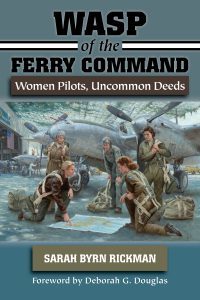 This project has the potential to grow. Two books are out there, but other inspiring WASP stories are waiting to be told. The stories of the women they inspired — the second and third generations of women pilots active today — also will need telling.
This project has the potential to grow. Two books are out there, but other inspiring WASP stories are waiting to be told. The stories of the women they inspired — the second and third generations of women pilots active today — also will need telling.
Christa McAuliffe said in 1985, when preparing for the flight of the Challenger, “I touch the future, I teach.”
I don’t teach, but I do write. So I borrowed three of her words: The Hall of Fame is “touching the future” by supporting the telling of these worthy stories from aviation’s past for the adults of tomorrow.
The Combs-Gates award honors its founder, the late Harry B. Combs, a 1996 NAHF Enshrinee who was a significant force in civil aviation. 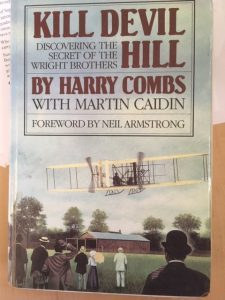 Combs also researched and wrote one of the definitive works on the brilliance of the Wright Brothers, Kill Devil Hill: Discovering the Secrets of the Wright Brothers. The late entrepreneur, Charles C. Gates, shared Combs’ passion for historic preservation, thus the award bears his name as well.
Combs also researched and wrote one of the definitive works on the brilliance of the Wright Brothers, Kill Devil Hill: Discovering the Secrets of the Wright Brothers. The late entrepreneur, Charles C. Gates, shared Combs’ passion for historic preservation, thus the award bears his name as well.
I’ve read Kill Devil Hill, it is terrific!
Combs stipulated that the award be established to encourage and support relevant aviation history research and preservation efforts. A panel of expert judges review each submission based upon criteria such as historical accuracy, creativity, potential for long-term impact, and value to the NAHF’s mission of honoring America’s outstanding air and space pioneers.
The post Sarah Wins Aviation Writing Award appeared first on Sarah Byrn Rickman.
August 18, 2019
38 WASP Died in WWII, 3 Were Original WAFS
Thirty-eight WASP perished performing their patriotic calling — flying for their country in World War II. All were young women, age 20 to early 30s — women whose futures would never be realized.
Cornelia Fort, a southern gentlewoman from Tennessee, loved flying. She also was on her way to becoming a proven 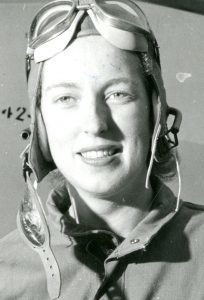 writer. Early on, Cornelia dedicated herself to writing the definitive story of Nancy Love’s original WAFS (Women’s Auxiliary Ferrying Squadron) — and, who knows, possibly the unfolding WASP saga beyond.
writer. Early on, Cornelia dedicated herself to writing the definitive story of Nancy Love’s original WAFS (Women’s Auxiliary Ferrying Squadron) — and, who knows, possibly the unfolding WASP saga beyond.
Cornelia, the second woman Nancy Love accepted, September 1942, was the first woman pilot to die on active service for the United States military. She was the victim of a senseless mid-air collision in which the other pilot survived. She was ferrying a basic trainer from California to Texas when the accident occurred, March 21, 1943.
Telling the WAFS Story As It Unfolded
Likely, the scarcity of WASP literature in the years immediately following WWII would have been remedied had Cornelia lived. Much admired and well liked by her fellow WAFS, she had the drive, dedication and resources to tell the story when it was fresh. The world might have known about the WASP long before the very late realization that such a program actually existed — that women pilots really flew for the US in World War II.
In all, Nancy Love lost three of her original WAFS.
Second to perish was friendly, outgoing, all-American girl Dorothy Scott. From tiny Oroville, Washington, up on the Canadian border, her desire to fly took her to the University of Washington, into the Civilian Pilot Training Program there, and thus to the WAFS.
She had the minimum for admission — 504 hours — but she was a truly fine pilot in whom her mentor, Nancy Love, saw potential.
Dorothy served as flight leader on ferrying trips with incoming WFTD graduates at the 5thFerrying Group WAFS squadron in Dallas May through July 1943. That fall, she was the welcoming liaison for the new WASP joining the Dallas ferrying group. She earned Love’s trust. Nancy chose her for a copilot on a C-47 delivery when Dorothy was building her twin-engine time.
Dorothy Pursuit School Bound
Nancy assigned Dorothy to the very first class at Pursuit School, December 1, 1943.
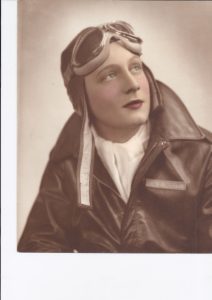 Dorothy died in a preventable mid-air collision on December 3, her third day in Palm Springs. She and her instructor were landing a BC-1 trainer when a faster P-39, also trying to land, overtook her. The deep, late afternoon shadows prevented him from seeing her in time. The control tower’s warning came too late. He came down on top of her and both aircraft crashed.
Dorothy died in a preventable mid-air collision on December 3, her third day in Palm Springs. She and her instructor were landing a BC-1 trainer when a faster P-39, also trying to land, overtook her. The deep, late afternoon shadows prevented him from seeing her in time. The control tower’s warning came too late. He came down on top of her and both aircraft crashed.
Dorothy, her instructor and the P-39 pilot all died that day.
And then there was Evelyn Sharp. Accepted into the WAFS on October 20, 1942 — her 23rdbirthday — Evelyn had logged an impressive 2,968 hours by the time she joined the WAFS.
Evelyn was the fourth woman, after Nancy Love, Betty Gillies and Barbara Erickson, to check out in the twin-engine P-38. She did so on March 26, 1944. Over the next three days she familiarized herself with the working of this magnificent aircraft with its two 1,425 horsepower engines. On March 29, she completed her transition.
We know the rest of the story. The following day she set her P-38 on a course for the docks at Newark, NJ — clear across the country. It was a trip she had made countless times in a P-51. On April 3, after being weathered in overnight in New Cumberland, PA — and having had problems with oil levels in both engines — she took off.
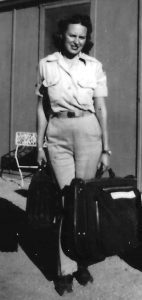 Barely in the air, her left engine belched black smoke and quit. Evelyn did not survive the subsequent crash. The impact drove the retracted nosewheel up into the cockpit and threw Evelyn into the bubble canopy breaking her neck.
Barely in the air, her left engine belched black smoke and quit. Evelyn did not survive the subsequent crash. The impact drove the retracted nosewheel up into the cockpit and threw Evelyn into the bubble canopy breaking her neck.
Nancy Love had lost her third Original WAFS. The young woman who had put many a 1930s canvas, dope and plywood aircraft down in the fields of Nebraska gave it her all and tried to bring the steel and aluminum dynamo back to earth safely. To no avail.
Hometown Airports Named for All Three
All three of the original WAFS who died while flying for the Army Air Forces in World War II have had a hometown airport named for them: Evelyn Sharp Field — Ord Municipal Airport, Ord, Nebraska; Dorothy Scott Memorial International Airport, Oroville, Washington; and Cornelia Fort Airpark, a small private airport located on the banks of the Cumberland River in Nashville Tennessee. Unfortunately, the airpark was badly flooded in 2010 and it is now part of Nashville’s Shelby Bottoms Greenway and Nature Park.
Tennessee’s own Rob Simbeck wrote the story of his fellow Nashvillian, Cornelia Fort. Daughter of the Air was published in 1999. Nebraska’s own Diane Ruth Armour Bartels—a Nebraska Ninety-Nine—wrote Sharpie: The Life Story of Evelyn Sharp, published in 1996. And yours truly, Sarah Byrn Rickman, wrote Finding Dorothy Scott, based on Dorothy’s wartime letters home, donated to the WASP Archives at TWU by her twin brother, Edward Scott. Published 2016.
Cornelia’s, Dorothy’s and Evelyn’s stories live on.
From Sarah Byrn Rickman: Thank you for reading my Blog. I hope you enjoy learning more about the WASP, the women who flew for the USA in World War II.
The post 38 WASP Died in WWII, 3 Were Original WAFS appeared first on Sarah Byrn Rickman.
August 1, 2019
99s Conference Meets in Dayton, Ohio
July 16-21, I returned to Dayton, Ohio — my home for 36 years. A visitor this time, I was there to attend my first International Ninety-Nines conference. I took my 10-year-old grandson, Daniel, with me. Why? Like his gramma, he’s caught the aviation bug big time!
The Ninety-Nines, or 99s, is the International Organization for Women Pilots. We 99s date our existence from Nov. 2, 1929, when 26 licensed women pilots, including Amelia Earhart, met at Curtiss Field, Valley Stream, Long Island, to discuss forming a woman pilot’s organization. All 117 licensed female pilots in the U.S., as of that date, received a letter from that core group inviting them to join. Ninety-nine responded. The organization was chartered and the group took the name 99s as representative of their charter members. Their first president, Amelia Earhart. This is our 90th anniversary.
I joined the 99s in 2011 after I earned my pilot’s license. The membership requirements? You must be a woman and you must be a licensed pilot. I qualified.
My WASP Books an Influence
My WASP books have had a big influence on Daniel, plus his daddy is a retired Air Force Lt. Colonel. We also live in Colorado Springs where aviation is BIG — the US Air Force Academy, Peterson and Schriever Air Force Bases and the new National Museum of World War II Aviation.
Daniel’s and my trip to Dayton became a reality when I was asked to be a presenter at the conference. When I lived in Dayton, I belonged to the All-Ohio Chapter of the 99s. That chapter is part of the North Central Section of the 99s. Together, they hosted the conference. My WASP books and I were a known quantity to them. Honored by the invitation, I immediately said “yes.” AND, I was invited to sell my books at the Author’s Corner and at the conference Fly Market.
We Sold All Our Books!
Daniel and I sold ALL 45 books we carried to the conference: The Originals, 25, and 10 each of my young adult WASP biographies, BJ Erickson: WASP Pilot and Nancy Love: WASP Pilot.
My other job while attending was to serve as my chapter’s voting delegate. I now belong to the Pikes Peak Chapter — South Central Section of the 99s. A quick plug: we are one of the fastest growing chapters right now, boasting an influx of younger members. I was the only member of our chapter attending the conference. Not a surprise. They all have day jobs! I’m my own boss and I gave myself the time off.
Our highlight was our two trips to the National Museum of the U. S. Air Force, aka the Air Force Museum. Having spent many an hour there when I lived in the Dayton suburb of Centerville, this was my first time back since the fifth hangar has been added. Already big, the museum is now huge and remains totally fascinating!
Visiting the ‘Memphis Belle’
Daniel and the ‘Memphis Belle’
Seeing the “Memphis Belle” topped Daniel’s list. Already I had 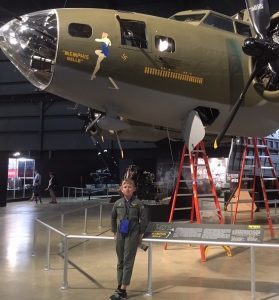 introduced him to the iconic wartime survivor — the B-17 that successfully completed 25 missions over Germany early in World War II, then returned home to the U.S. to lead our country’s Liberty Bond Drive in late 1943 and 1944. Daniel already has a model in his room.
introduced him to the iconic wartime survivor — the B-17 that successfully completed 25 missions over Germany early in World War II, then returned home to the U.S. to lead our country’s Liberty Bond Drive in late 1943 and 1944. Daniel already has a model in his room.
When I heard the museum would have the restored aircraft on permanent display, I knew we both had to see it. As part of the 99s conference group we were treated to an informative lecture on the Memphis Belle, its story and its restoration. And we saw her in person.
As our guide all day Wednesday July 17 — as well as for our repeat visit the afternoon of Sunday July 21 — we had my long-time friend Judith Wehn, who served as Education Director at the NMUSAF for 31 years and just recently retired. If ever there was an individual with not only the story, but also the backstory, of the museum and its exhibits, Judith is the one. Daniel and I got full benefit of her knowledge and sense of humor, making the exhibits come alive. In our very full 1½ days we saw the entire museum! And that’s a trek!!!
Seeing the D-Day Exhibit
Daniel did the iPad-like tour of the D-Day exhibit 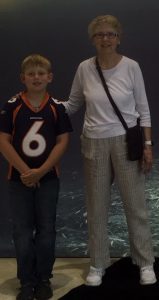 and Judith and I followed him, taking it all it. He rode simulators. He walked through every aircraft we had access to, including the Presidential aircraft. He sat in every fighter cockpit available.
and Judith and I followed him, taking it all it. He rode simulators. He walked through every aircraft we had access to, including the Presidential aircraft. He sat in every fighter cockpit available.
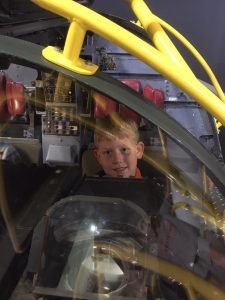 Thursday night, the Amelia Earhart Scholarship Awards banquet was held under the wings in the new fifth hangar. We dined looking at Air Force One.
Thursday night, the Amelia Earhart Scholarship Awards banquet was held under the wings in the new fifth hangar. We dined looking at Air Force One.
Our theme was: The Wright Way to Dayton, the Birthplace of Aviation — the home of the Wright Brothers, Orville and Wilbur. All this on the occasion of the Ninety-Nines 90thanniversary 1929-2019. All the aviation-related historical sites in my former hometown were open and available to my 200 fellow 99s attending, with tours scheduled over 3½ days.
(Left) Daniel: one hot pilot! (Right) Daniel and I visit D-Day exhibit.
Hope you’ve enjoyed reading about Daniel’s and my adventures in Dayton last month. And I hope you are reading and enjoying my WASP books as well. Among them: The Originals, also BJ Erickson: WASP Pilot and Nancy Love: WASP Pilot.
Thanks, Sarah Byrn Rickman
The post 99s Conference Meets in Dayton, Ohio appeared first on Sarah Byrn Rickman.
July 26, 2019
The Originals — An Excerpt from Chapter 17
Colonel Tunner had four PT-26s — PT-19s with canopies — that needed to be delivered to the Canadian RAF near Calgary, Alberta, before Easter. It was now the Friday afternoon before Palm Sunday. Knowing the importance of the assignment, Colonel Baker chose his WASP squadron commander, Betty Gillies, 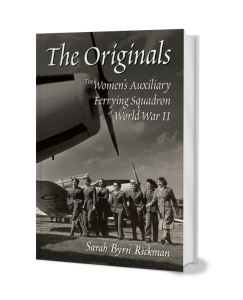 to make this important mission happen. Betty chose Nancy Batson, Sis Bernheim and Helen McGilvery.
to make this important mission happen. Betty chose Nancy Batson, Sis Bernheim and Helen McGilvery.
PT-26s have a cruising speed of about one hundred miles per hour. When Betty told her crew where they were going and how long they had to get there, the three stared at her in total disbelief. “I know, that’s more than 2,500 miles,” Betty said, “but I promised Colonel Tunner and Colonel Baker we’d get them there before Easter.”
Easter was nine days away. Batson let out a long, low whistle. “That doesn’t allow for any weather along the route.”
Betty nodded. “I know.” What she didn’t tell them was she had great faith in their abilities.
‘We’re Goin’ to Canada!’
Very early Palm Sunday morning, they were in Hagerstown checking out their aircraft. “Eeeeyow!” Nancy let out a Rebel yell as she climbed into the cockpit of her PT-26. “We’re goin’ to Montana and on to Calgary, Canada!”
They left Hagerstown early, headed west across spring’s shades-of-green patchwork quilt of Ohio, Indiana, and Illinois. The four ran out of daylight in Joliet, Illinois, but not before they had flown an astounding 697 miles. Nancy noted that the weather was improving. From Alabama, Nancy felt like winter lasted forever in Delaware where they were statiioned. But spring was on the way. Besides, these airplanes had canopies so they didn’t have to contend with wind in their faces andicicles forming on their runny noses.
That night at the hotel, Betty informed them that we would be up at four in the morning. “We’re going to get an early start,” Betty said. “I want to be sitting in our cockpits with the engines running when the sun breaks the horizon. Now get some sleep. Tomorrow’s a long day.”
Sis and Little Mac began to howl — “Today was a long day,” said Sis. “We went seven hundred miles!” said Little Mac.
“Four a.m.,” said Betty.
Also Known as ‘O’ Dark Thirty’
Batson, on her way to bed, overheard Sis and Mac grumbling. They said there was no way in you-know-where that they were going to get up at four o’clock in the morning. Well, I listened to them bellyache for a few minutes and I got mad. Betty was putting her reputation on the line and here these two were saying they were too good and too tired to get up in the morning and get a move on and help get those planes out to Canada on time like Colonel Tunner wanted.
I marched into their room and gave them what-for. Well, when I got through, they just stared at me. Then I turned on my heel and walked out and went to bed. The next morning, I was in the lobby at four a.m., dressed and ready to go. And you know what, so were they!
We were sitting in our cockpits when dawn broke and we were off in a flash, headed due west again. This time our destination was North Platte, Nebraska, a six-hundred-mile flight. We crossed the Mississippi and pretty soon we were looking down on the cornfields of Iowa and later on the wheat fields of Nebraska. It was like I’d never seen corn and wheat fields before.
We crossed the Missouri River below Omaha and kept on cruising until we hit North Platte. We were beginning to enjoy ourselves by then. Here we were, three Easterners and a Southerner, and we were crossing this great big country of ours. This country we were fighting for. We were so proud of that fact. And, by golly, we were headin’ west in the cockpits of sleek new Army airplanes and somebody else was paying for the gas.
Just Doin’ Their Job
Up at four again the next day. That night, we made Great Falls, Montana, a whopping 850-mile flight from North Platte. When we got there, Betty reminded us — rather proudly, I think — that we had just done it in airplanes that had an average ground speed of one hundred miles per hour.
“Did you see those mountains!” said Sis.
The next day, up at four again, we flew along those majestic snow-capped Canadian Rockies. What we had seen the previous day was nothing compared to this. The last leg was only 275 miles from Great Falls. We had delivered the planes from Hagerstown in a record four days — and four days before the Easter deadline. Betty had done her job — so had the rest of us. And done it well. We talked a lot on the train ride back.
The four of us were back on base by Friday night, April 23 — Good Friday. And do you know what that sweet Colonel Baker did? He gave us all a Commendation — “for our efficient and prompt delivery which included not only flying the planes but also the paper work involved in such deliveries, flight logs, gasoline reports, RON messages, etc.” I gotta tell you, I’m real proud of that!”
What Betty and the others had proved was what their leader Nancy Love already knew — that women made excellent ferry pilots. Now Nancy could point with pride to their accomplishment and tell the men to whom she answered that there was a lot more where that came from.
*****
Sarah Byrn Rickman here: I hope you enjoyed this excerpt from Chapter 17 of The Originals.
The post The Originals — An Excerpt from Chapter 17 appeared first on Sarah Byrn Rickman.

